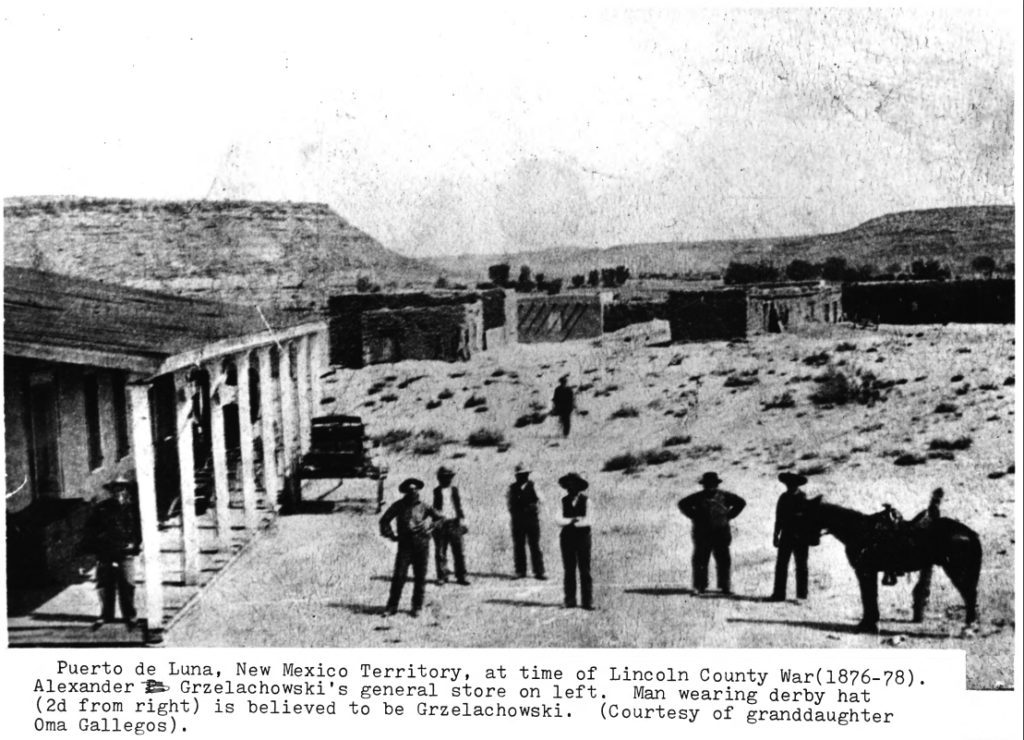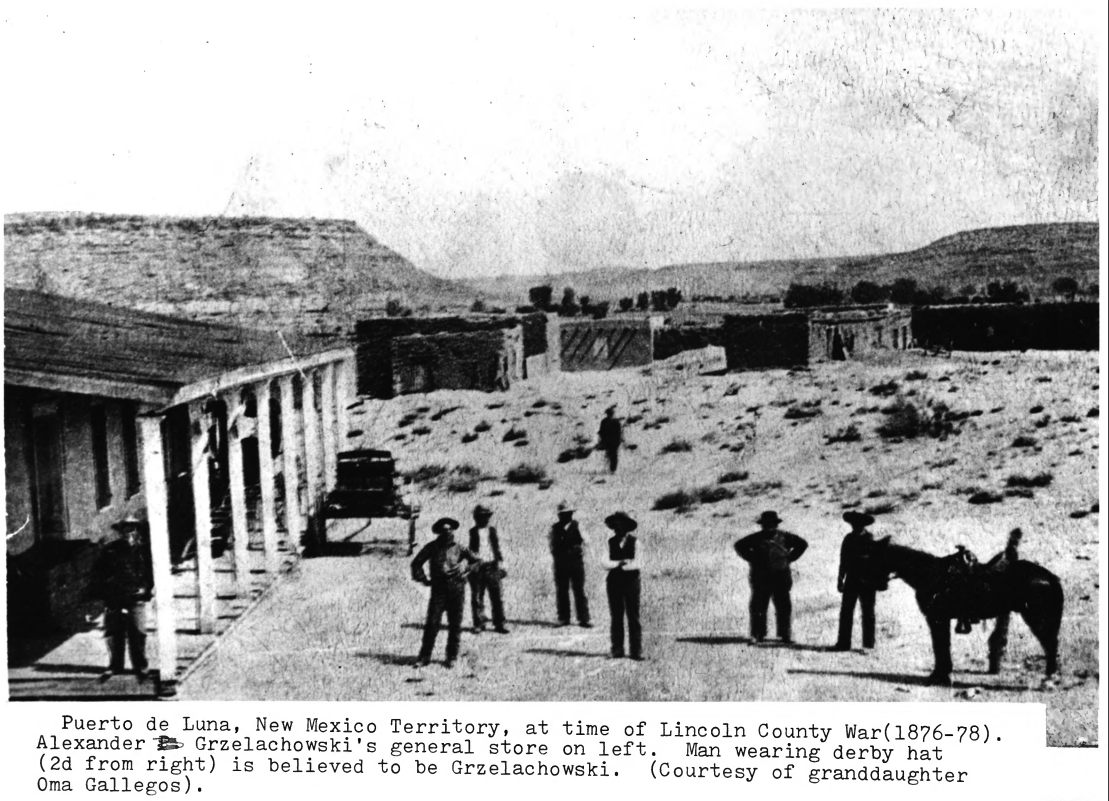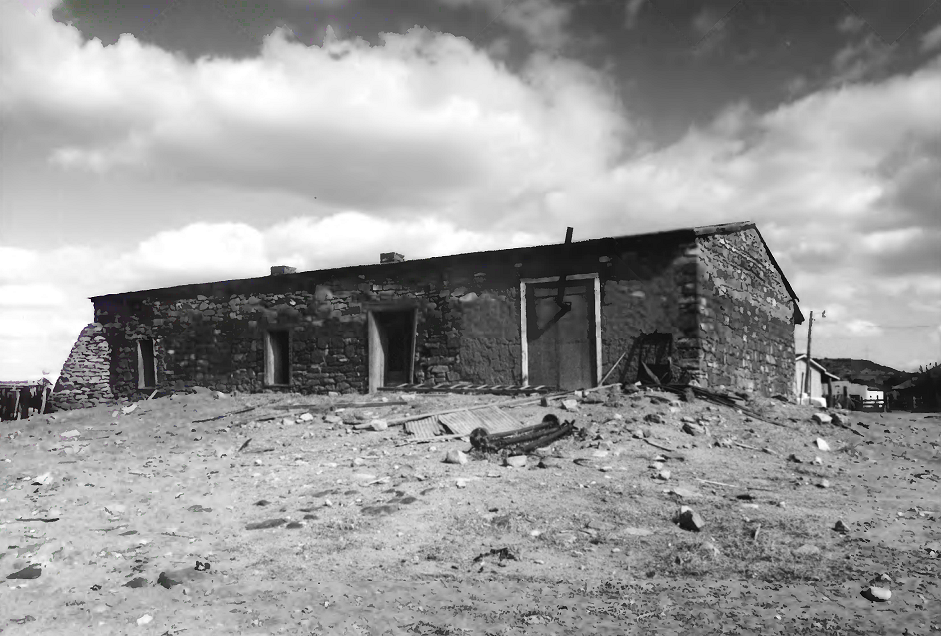Constructed in the mid 1870s, the building served as a residence, general store, post office, and warehouse. Grzelachowski may have been influenced in his choice of style by his familiarity with Fort Union, an important precedent for the post Civil War, New Mexico Territorial style. The domestic section was occupied by Grzelachowski, his common-law wife Secundina C. de Baca, and
their nine children. The large room at the south end contained Grzelachowski f s store and the post office. The now demolished adobe rooms at the back of the building are thought to have contained warehouse rooms for goods and a basement jail. The building and gardens were a local showplace, having it is said the first metal roof in Puerto de Luna and one of the largest orchards in the area.

The store was a popular stop for area ranchers and travelers through the Pecos Valley. In 1877 Captain J. G. Clancy drove 3,000 head of sheep from California to New Mexico bringing with him fifty thousand dollars in gold. The coins were placed in the large safe at Grzelachowski’sqstore, for a long time the only safe of its kind and size in the territory. Billy the Kid frequented the Grzelachowski store. A.J. Padilla, who was married to Grzelachowski f s daughter, was the source of many stories told to him by his mother-in-law. Billy, she said, was fascinated by Grzelachowski’s learning and by his tales. He would listen intently and beg Grzelachowski to speak Latin, Polish, or Greek. Billy would stand in front of the store and shoot at tin cans, shifting his gun from hand to hand and shooting as well with either. Grzelachowski instructed his clerks not to argue with Billy and to give him anything he wanted. Once when Grzelachowski was away, the clerks saw Billy riding into town with a few of his companions and immediately ran out the back door. Finding the store deserted, Billy and his friends took what they needed and rode on. Several days later when he returned through town, the Kid asked Grzelachowski what he owed. Grzelachowski replied that he didn’t think that the Kid owed anything. Another time a clerk noticed the Kid taking ammunition and accused him of trying to steal from a friend. Whereupon Billy put the boxes back.
Pat Garrett also passed through Puerto de Luna often and stopped at Grzelachowski’s store. In his ghost-written and self-justifying Authentic Life of Billy the Kid, he describes an incident that took place on December 9, 1880 when he was passing through with a deputy and two prisoners.
“I was sitting in the store of A. Grzelachowski, when…a Mexican named Mariano Leiva [Marino Leyba], the big bully of the town, entered, his hand on a pistol in his pocket, walked up to me and said he would like to see any d——d Gringo arrest him. I told him to go away and not annoy me. He went out on the porch, where he continued a tirade of abuse, all directed against me. I finally went out and told him that I had no papers for him and no business with him…With an oath, he raised his left arm in a threatening manner, his right hand still on his pistol. I slapped him off the porch. He landed on his feet—the second shot went through his shoulder, when he turned and ran, firing back as he went, way wide of the mark.
I entered the store and got my Winchester. In a few moments Deputy Romero came in and informed me that I was his prisoner. I brushed him aside and told him I did not propose to submit asking him the cause of my arrest. He said it was for shooting at Leiva, and reached for my gun. I told him I had no intention of evading the law, but he could not disarm me…and I proposed to keep my arms and protect myself…My friend, Grzelachowski, interfered in ray defense and the bold deputy retired. I went to an Alcalde the next morning, had an examination, and was discharged.”
Deputy Romero in a sworn affidavit gave his own more detailed account of the same incident which took place when he was sent from the Las Vegas to meet Pat Garrett at Puerto de Luna to take possession of fugitives from the San Miguel County jail whom Garrett, Sheriff of Lincoln County, had captured.
We left Las Vegas about 12 o 1 clock noon and arrived next day at Puerto de Luna but did not meet Pat; he had not yet arrived. The following day…we went out to meet him…we drove back and when we arrived at Puerto de Luna we met a group of people who were trying to find out what was going on. When we got to A. Grzelachowski f s store we still found a larger group. There I presented my credentials to Pat and he delivered the prisoners to me…I left with Ortiz and Sandoval, taking Webb along with us to a blacksmith shop nearby to get some fetters…Pat and Mason remained at Mr. Alejandro Grzelachowski’s store. And when we were in the blacksmith shop I heard shots in succession, whereupon I…went towards where I thought the shots had been fired and at the same time seeing many people that were going in a hurry toward Mr. Grzelachowski’s store…While going towards Mr. Grzelachowski f s place, I met Marino [Leyba] on horseback …with his
right hand he opened his shirt and found a wound in his left shoulder and kept going on his horse, galloping. When I arrived at Grzelachowski T s store, I saw a lot of people gathered there in a group trying to get into the store and many other people running towards the same direction. Having arrived at the store I made my way in and told the people not to come in. Within about eight or ten feet from the door Pat was sitting upon the counter with his gun in his hand…he discharged the gun without hurting anyone; at that time and up to the present I never did think that he shot at me, for the shot hit under the counter. I got to him, took the rifle away from him and told him that he was under arrest, to which he inquired by what authority I was arresting him…I took out my credentials from my pocket and showed them to him, he giving up his weapons which I handed to Mr. Grzelachowski…the people all in a group wanted to come into the store, but at once I raised up my gun and aimed it toward the door saying that no one should enter, whereupon all kept back. All the people were alarmed and it seemed as though they wanted recourse to violence. I told Mr. Grzelachowski to close the door and I was informed how and why the shots had been fired upon Marino. I told Pat and Mason to remain in the house…Next day I took them over to a Justice of the Peace and after a hearing he set them free. After that we got ready to leave for Las Vegas.
Leyba was later accused of being the leader of a gang of bandits that had robbed and killed Colonel Charles Potter the preceding October. Because all of the other witnesses to the murder had already been lynched by vigilantes, Leyba was indicted on charges, among others, of “assault with intent to kill and murder” Pat Garrett. Convicted, he was fined $80.
On Christmas day, a week after the incident with Leyba, Garrett stopped off at Grzelachowski f s store on route to Las Vegas with seven deputies and four prisoners including Billy the Kid who had been captured near Fort Sumner. According to Garrett,
“We reached Gayheart’s ranch with our prisoners about midnight, rested until eight in the morning, and reached Puerto de Luna at two o f clock p.m. on Christmas Day. My friend Grzelachowski gave us all a splendid dinner.. 2JJith a fresh team we got away from Puerto de Luna about four o 1 clock.
The following summer, on July 14, Garrett shot Billy the Kid in Pete Maxwell T s house at Fort Sumner.
After Grzelachowski f s death the house continued to be used by his family. His son Adolph took over management of the general store and occupied the house with his family until about the time of World War I- His brother, Oscar, then lived there with his family until about 1926. The house was eventually acquired by Cipriano Flores. He and his wife lived there until their deaths in the mid 1960s. During the time the Flores occupied the house, the floors were covered with linoleum, (now removed), the ceilings in the first two front rooms on the north were lowered, and electricity was put in. There was, and still is, no running water in the house. Cabinets (now removed) were put into the first room on the north which served as a kitchen. The room that had contained the Grzelachowski store and post office was used for storage. The Flores 1 granddaughter, Margie Abeyta, who lived with them, inherited the property which she then sold to. Cipriano’s son, her uncle and the present owner, Victor Flores.
The building has been empty since the mid 1960s. In 1970 the Grzelachowski House and Store was listed in the New Mexico State Register of Cultural Properties as SR 176. In the late 1970s the badly deteriorated, adobe storage rooms extending from the back of the store were torn down. In the fall of 1991 and again in 1992, celebrations at the house featured reenactments of Billy the Kid’s last Christmas dinner at the Grzelachowski House.
Source: National Register of Historic Places
Quoted in full by Adams, A Fitting Death for Billy the Kid (1960):
Garrett, The Authentic Life of Billy the Kid (1954); 107-8. Quoted in
full by White, “The Murder of Colonel Charles Potter (1987):
Adams, Ramon F. A Fitting Death for Billy the Kid. Norman: University of
Oklahoma Press, 1960.
Albuquerque Tribune. September 25, 1955.
Anderson, George B. History of New Mexico; Its Resources and People, II. Los
Angeles: Pacific States Publishing Company, 1907.
Chaves, Fray Angelico. Archives of the Archdiocese of Santa Fe. 1678-1900.
Washington, B.C.: Academy of American Franciscan History, 1957.
Garrett, Pat. The Authentic Life of Billy the Kid. Norman: University of
Oklahoma Press, 1954.
Illustrated History of New Mexico. Chicago: The Lewis Publishing Company,
1895.
Kajencki, Francis C. “Alexander Grzelachowski: Pioneer Merchant of Puerto de
Luna,” New Mexico Historical Review 26 (Autumn 1984): 243-260.
. “The Battle of Glorieta Pass: Was the Guide Ortiz or
Grzelachowski?” New Mexico Historical Review 62 (January 1987): 47-54.
_______________________. Poles in the 19th Century Southwest. El Paso, Texas:
Southwest Polonia Press, 1990.
Keleher, William A. The Fabulous Frontier, Albuquerque: University of New ;
Mexico Press, 1982 (orig. 1945, rev. 1962).
New Mexico Business Directory, Denver, Colorado: The Gazetteer Publishing Co.,
1905
Parish, William J. The Charles Ilfeld Company. Cambridge, Massachusetts:
Harvard University Press, 1961.
Rittenhouse, Jack D. “Alexander Grzelachowski store, warehouse, and home (one
structure)” Application for Registration. New Mexico State Register of
Cultural Properties. April 23, 1970.
Stanley, F. The Puerto de Luna, New Mexico Story. Nazareth, Texas: By the
author, 1969.


1 thought on “HISTORY OF THE ALEXANDER GRZELACHOWSKI HOUSE AND STORE”